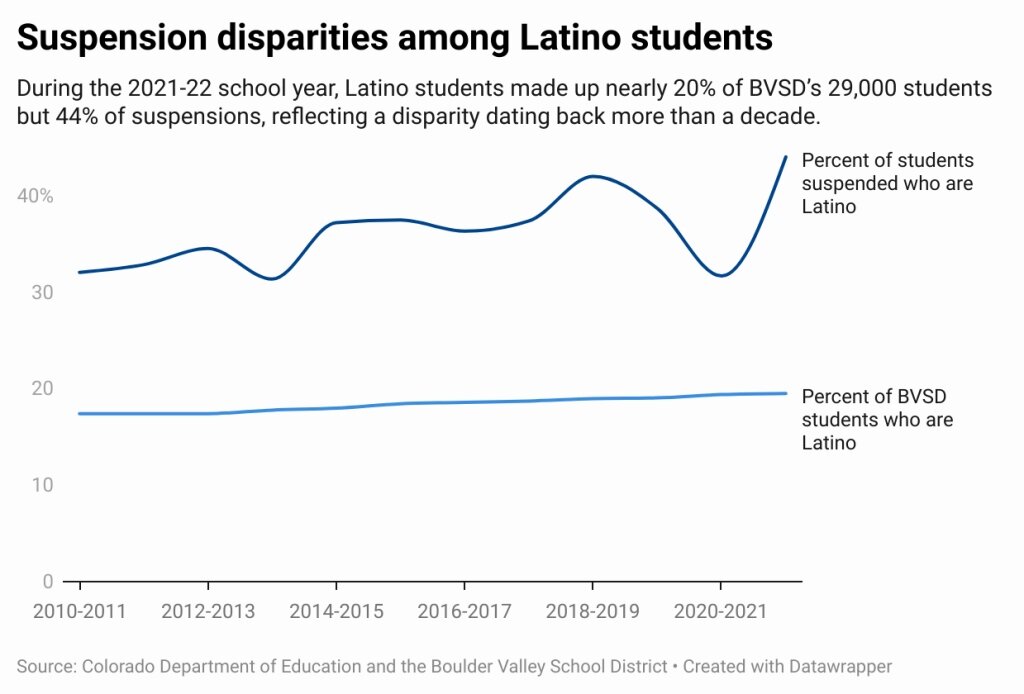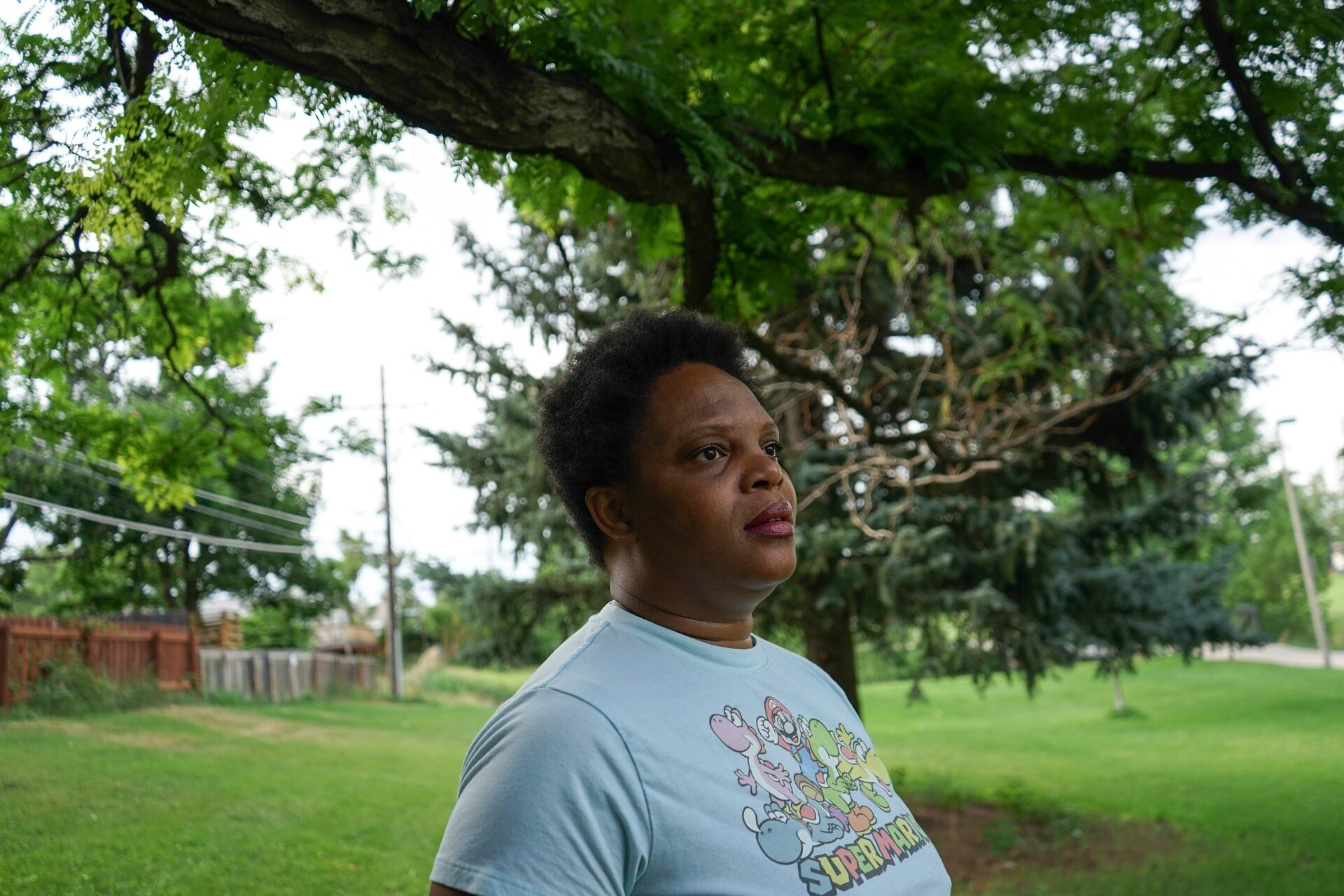Boulder Valley School District punishes Black and Latino students at disproportionately high rates


BOULDER, Colo. — Black and Latino parents of Boulder Valley School District students have been raising alarms for years that their children are punished more often for the same behaviors as white students. The district’s own data has consistently shown this disparity.
In 2020, under mounting pressure, BVSD reformed its discipline policies to try to reduce inequities. It removed police from schools, streamlined punishment guidelines across classrooms, and trained educators to de-escalate and resolve conflicts without resorting to punishment.
Since the reforms, fewer students have been suspended or referred to police. But the disparities that prompted the new policies remain.
Latino students were about 3.5 times more likely to be suspended than white students during the 2021-2022 school year, according to data provided to Boulder Reporting Lab by the district. That figure reflects a disparity dating back more than a decade.
While Latino students made up nearly 20% of BVSD’s 29,000 students, they accounted for about 44% of the suspensions.
The data indicate Latino students are generally punished for the same behaviors as their white peers — threats of physical harm, disobedience, fighting, possessing tobacco and marijuana.
Suspensions and police referrals can have lasting impacts on young lives. Such punishment reduces the odds of graduating, makes it harder to excel academically, and increases the chances of entering the criminal legal system.
“There has not been progress,” said Noemi Lastiri, member of the Latino Parent Advisory Council, which the district set up to advise it on equity issues. “Kids in high school keep complaining that they are not treated equally by teachers or by staff.”

To contextualize the trends in Boulder, BRL analyzed data from the Colorado Department of Education for the state’s 12 largest districts for the 2010-2011 to 2018-2019 school years. (Discipline data is unreliable for much of 2020 and 2021 because of Covid-19. The state has not finalized 2021-2022 data.)
This story is part of Chasing Progress, a Colorado News Collaborative project on social, economic and health equity among Black and Latino Coloradans.
Notably, BVSD’s overall suspension rate is lower than most of the state’s largest districts, according to data from 2018-2019. But that same year, it had the highest disparity in the suspension rates between Latino and white students among those districts.
When analyzing all the punitive measures reported to the state — removal from the classroom, in- and out-of-school suspensions, referrals to police — BVSD’s Black students were 2.5 times more likely to be punished than their white peers. Latino students were two times more likely to be punished.
BVSD’s superintendent, Rob Anderson, joined the school district in 2018 after overseeing a much larger district in Atlanta, Georgia. He said the disparities in Boulder reflect the systemic racial and ethnic disparities across the nation.
“Before starting in the school district, I reviewed the data and realized that, you name the metric, we were disproportionate,” Anderson said in an interview.
Disproportionate discipline isn’t the only problem for Black and Latino BVSD students. They’re less likely to graduate, enroll in advanced courses, or join its gifted and talented program.
“When you think about our discipline disproportionality, it aligns with our achievement disproportionality,” Anderson said.

During his first year on the job, he created the Latino Parent Advisory Council to address these disparities. The council is one of the only platforms of its kind in Colorado to give parents a voice in district policies. At the request of the group, the district said it will begin publishing data on its website in August 2022 that breaks down disparities by each of its 57 schools.
The data will help the district identify how policies are playing out.
“We have a long way to go to get better. And the only way you can get better is if you really own and understand the issue,” Anderson said. “You start to look at data and use data as a mirror to see where those things are working or not working. It could be that the district’s disproportionality is really being heavily influenced by a handful of schools.”
Parents interviewed for this story support reforms made so far by the district. But they say the changes don’t go far enough. They would like to see leniency for students who defend themselves from bullying, along with more teacher accountability.
“For the first time [BVSD] acknowledges that they have not made progress, that we still have a huge problem. And I think that’s a start,” said Ana Fernandez Frank, co-coordinator of the Latino Parent Advisory Council. “But we want to see what they’re planning on actually doing.”
Related Story

Bullying and self defense
Jamillah Richmond is the founder of the Parents of Color Council, a separate group advising the district. Her nine-year-old daughter attends a BVSD school.
She said her daughter has been sent to the office for responding to bullying at her elementary school. In one instance, she said, her daughter was cornered by four white students. She pushed one of them away. In another instance, a boy kept touching her hair so she slapped his hand. In both situations, her daughter faced repercussions.
“Culturally, if you touch our hair, we’re slapping your hand, which is exactly what my daughter does. But she gets punished,” Richmond said.
Other parents of Black and Latino students told Boulder Reporting Lab about similar situations in which their kids were punished after defending themselves.
“We need to stop penalizing children of color for defending themselves when they’re being confronted with different varying degrees of violence,” Richmond said.
For this reason, she prefers not to use the phrase “disproportionate discipline.”
“Discipline implies a kid did something wrong to begin with,” she said. “You are not wrong for defending yourself.”
The district’s discipline matrix, which it created in 2020 to offer punishment guidance to schools, includes no mention of self-defense. Richmond thinks it should, to encourage educators to consider context around instances of violence.
“If it’s not on paper, and we don’t have a clear and definitive definition of what these things are and what consequences could or could not be applied to them, then we’re leaving too much room open for interpretation and trusting people who have blind spots and biases,” she said. “And I think that leaves open space for discrimination.”
Anderson, BVSD’s superintendent, agrees bullying is a concern. The district has made it easier to report bullying on its website. But he said it’s tricky to balance physical force with school safety.
“If you’re blocking punches so you don’t get hurt, that’s self-defense. If you engage in a physical altercation with someone else, we don’t view that as self-defense,” he said.
Parents can appeal disciplinary measures to the district’s Board of Education. But Jorge Chavez, chair of the District Accountability Committee, an oversight panel required under state law, said some parents face challenges in speaking out.
“I’m pretty fortunate. I’m an immigrant, but I’m bilingual. I know how the system works here,” Chavez said. “For a lot of parents who either don’t feel comfortable with the English language, who aren’t familiar with the educational system, who don’t have the resources and the time to get involved, it’s harder for them to have their voices elevated to where their concerns are being heard.”
‘We all have unconscious biases’
The district is open about discussing how structural inequities contribute to disparities in discipline. But some want it to do more to acknowledge racial bias among staff.
“The root cause is racism. We have to call it what it is so that we can address it. I’m not saying that teachers are bad people or anything. We all have unconscious biases,” said Fernandez Frank, of CAPL, the acronym for the Spanish name for the parent group, Consejo Asesor de Padres Latinos.
That’s why, first and foremost, parents want the district to hire more Black and Latino teachers and staff. Kids do better in school when their teachers look like them. BVSD’s teachers were 86% white last school year, about the same as the state average. Their students were 67% white.
In February, the district hosted a “Teachers of Color Hiring Event.” Boulder pays teachers more than any other district in the state. But Anderson said the region’s high cost of housing and low turnover rate makes hiring difficult. “It becomes incredibly challenging to try to diversify your workforce very quickly, because you just don’t have the vacancies.”
Parent groups have also been asking for data on teachers’ disciplinary referrals. And they want the district to include in staff evaluations any racial disproportionality in their punishment of students. They also want a public process for filing and tracking discrimination complaints.
“They keep kids accountable for their actions. And I think that it’s only fair that adults are held to a similar standard,” Fernandez Frank said.
Anderson opposes such measures.
“I don’t think that’s a good idea. I think that creates a culture of fear. You need to have people open to get better,” Anderson said. “My goal here isn’t to place blame on folks. It’s to fix the systemic issues.”
The district already kicked off monthly meetings in each school to devise solutions. This may include cultural competency training. “That’s why you have these conversations locally,” he said. “Locally, it may be that there are teachers who do need additional training or grade levels who want the additional training.”
This difference will likely remain a sticking point.
“I don’t want to wait until they fix their unconscious bias. I want them not to be in contact with kids,” Fernandez Frank said. “Those kids are going to continue to suffer until this teacher learns. And I don’t think that’s fair for students.”